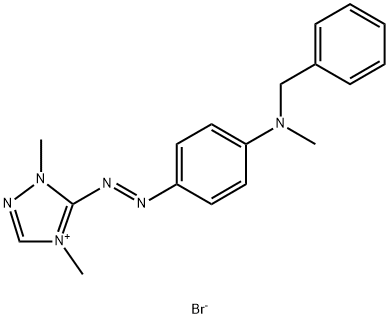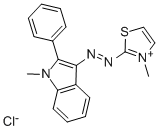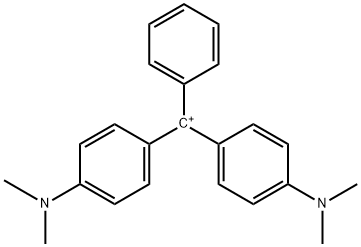Basic Red 9
Synonym(s):Fuchsin basic;Basic Violet 14;Pararosaniline;Basic Red 9;Basic Fuchsin
- CAS NO.:569-61-9
- Empirical Formula: C19H17N3.ClH
- Molecular Weight: 323.82
- MDL number: MFCD00001657
- EINECS: 209-321-2
- SAFETY DATA SHEET (SDS)
- Update Date: 2025-01-27 09:38:02

What is Basic Red 9?
Chemical properties
green crystalline powder
Chemical properties
C.I. Basic red 9 is a colorless to red crystalline solid or green powder.
The Uses of Basic Red 9
Antischistosoma.
The Uses of Basic Red 9
Pararosaniline Hydrochloride is a red dye used for textiles. Dyes and metabolites, Environmental Testing.
Preparation
commonly known as (Para Magenta, Para Rosaniline) (a) 4-(4-Aminobenzyl)benzenamine?and aniline, Aniline hydrochloride, the difficulties and ferric chloride in 170 ℃ heating hours;?(b) aniline,p-Methylaniline and its hydrochloride and iron, ferrous chloride or 1-Nitrobenzene?heating; (C) aniline?and p-Methylaniline?was treated with arsenic oxide; (d) aniline?tetrachloride carbon heat.
Definition
ChEBI: A hydrochloride that is the monohydrochloride of 4,4'-[(4-iminocyclohexa-2,5-dien-1-ylidene)methanediyl]dianiline. One of the major constituents of Basic fuchsin, together with rosanilin, magenta II and new fuchsin.
General Description
Colorless to red crystals or green powder.
Air & Water Reactions
Insoluble in water.
Health Hazard
ACUTE/CHRONIC HAZARDS: When heated to decomposition Basic Red 9 emits very toxic fumes of hydrogen chloride and nitrogen oxides.
Fire Hazard
Flash point data for Basic Red 9 are not available; however, Basic Red 9 is probably combustible.
Safety Profile
Confirmed carcinogen with experimental carcinogenic and tumorigenic data. Mildly toxic by ingestion. Mutation data reported. When heated to decomposition it emits very toxic fumes of HCl and NOx.
Potential Exposure
Used as a dye for textiles, paper; printing, computer and photo imaging inks, leather, and many consumer products; as a microbiological/microscopy stain for bacilli, including tubercle and influenza.
Carcinogenicity
Basic red 9 monohydrochloride is reasonably anticipated to be a human carcinogen based on sufficient evidence of carcinogenicity fromstudies in experimental animals.
Shipping
UN 3143 Dyes, solid, toxic, n.o.s., or dye intermediates, solid, toxic, n.o.s., Hazard Class: 6.1; Labels: 6.1—Poisonous materials, Technical Name Required.
Properties and Applications
colourful red blue light. Slightly soluble in cold water, soluble in hot water for red, easily soluble in ethanol is cherry red. The strong sulfuric acid for yellow brown, after dilute for purple. Used in the manufacture of blue ink, also can dye tannins mordant dyeing cotton.
| Standard( Cotton ) | Light Fastness | Persperation Fastness | Ironing Fastness | Soaping | |||
| Fading | Stain | Fading | Stain | Fading | Stain | ||
| A | 2 | 1 | 1 | ||||
Incompatibilities
May be combustible; powder or liquid may form explosive mixture with air. Incompatible with oxidizers (chlorates, nitrates, peroxides, permanganates, perchlorates, chlorine, bromine, fluorine, etc.); contact may cause fires or explosions. Keep away from alkaline materials, strong bases, strong acids, oxoacids, epoxides.
Waste Disposal
Use a licensed professional waste disposal service to dispose of this material. Dissolve or mix the material with a combustible solvent and burn in a chemical incinerator equipped with an afterburner and scrubber. All federal, state, and local environmental regulations must be observed.
Properties of Basic Red 9
| Melting point: | 250 °C |
| Boiling point: | 479.57°C (rough estimate) |
| Density | 0.999 g/mL at 20 °C |
| refractive index | n |
| Flash point: | 11 °C |
| storage temp. | Store at RT. |
| solubility | ethanol: soluble1mg/mL |
| form | Solid |
| Colour Index | 42500 |
| color | metallic green |
| PH Range | 1.0 - 3.1, purple to red |
| Water Solubility | 10 g/L (25 ºC) |
| λmax | 545 nm |
| BRN | 4164603 |
| Stability: | Stable. Incompatible with strong oxidizing agents. |
| Biological Applications | Detecting breast cancer; treating pathogens |
| CAS DataBase Reference | 569-61-9 |
| IARC | 2B (Vol. 57, 99) 2010 |
| EPA Substance Registry System | C.I. Basic Red 9, monohydrochloride (569-61-9) |
Safety information for Basic Red 9
| Signal word | Danger |
| Pictogram(s) |
 Health Hazard GHS08 |
| GHS Hazard Statements |
H350:Carcinogenicity |
| Precautionary Statement Codes |
P201:Obtain special instructions before use. P202:Do not handle until all safety precautions have been read and understood. P280:Wear protective gloves/protective clothing/eye protection/face protection. P308+P313:IF exposed or concerned: Get medical advice/attention. P405:Store locked up. P501:Dispose of contents/container to..… |
Computed Descriptors for Basic Red 9
| InChIKey | JUQPZRLQQYSMEQ-UHFFFAOYSA-N |
Basic Red 9 manufacturer
ARRAKIS INDUSTRIES LLP
New Products
3-Iodophenylacetic acid 3-Pyridineacetonitrile, α-hydroxy- 2-Propanamine, 1-chloro-, hydrochloride (9CI) 3-(hexyloxy)-4-(pyridin-3-yl)-1,2,5-thiadiazole 2-Hexyn-1-ol Dibenzo-18-crown-6 Nickel(II) perchlorate hexahydrate, 98% 4-Bromophenylacetonitrile, 95% 3-Bromo-4-fluoroaniline, 97% Sodium tetraborate decahydrate, 98% Palladium(II) acetate, trimer, Pd 99% 4-Bromo-2-chlorotoluene, 97% N N Dimethylformamide Dimethyl Acetal (Dmf Dma) 2,3-Dichloro Benzoyl Cyanide [Side Chain] Bis(2-Chloroethyl) Amine Hydrochloride L-Glutamic Acid Diethyl Ester Hydrochloride 5-(Difluoromethoxy)-2-Mercaptobenzimidazole 1-Ethyl-3-(3-Dimethylaminopropyl)-Carbodiimide Hydrochloride [EDC Hcl] 1,4-Napthoquinone Bromoiodomethane Sodium Bicarbonate Methylene Dichloride (MDC) Ethyl Acetate Indole-3-Carbinol (I3C)Related products of tetrahydrofuran








You may like
-
 Fuchsin hydrochloride 569-61-9 98%View Details
Fuchsin hydrochloride 569-61-9 98%View Details
569-61-9 -
 Pararosaniline Hydrochloride CAS 569-61-9View Details
Pararosaniline Hydrochloride CAS 569-61-9View Details
569-61-9 -
 Basic Red 9 98% (HPLC) CAS 569-61-9View Details
Basic Red 9 98% (HPLC) CAS 569-61-9View Details
569-61-9 -
 Rosaniline hydrochoride CAS 569-61-9View Details
Rosaniline hydrochoride CAS 569-61-9View Details
569-61-9 -
 Pararosaniline Hydrochloride CAS 569-61-9View Details
Pararosaniline Hydrochloride CAS 569-61-9View Details
569-61-9 -
![Pararosaniline Hydrochloride [for Biochemical Research] CAS 569-61-9](https://img.chemicalbook.in//Content/image/CP5.jpg) Pararosaniline Hydrochloride [for Biochemical Research] CAS 569-61-9View Details
Pararosaniline Hydrochloride [for Biochemical Research] CAS 569-61-9View Details
569-61-9 -
 Pararosaniline hydrochloride 85% CAS 569-61-9View Details
Pararosaniline hydrochloride 85% CAS 569-61-9View Details
569-61-9 -
 Basic Fuchsin CASView Details
Basic Fuchsin CASView Details
